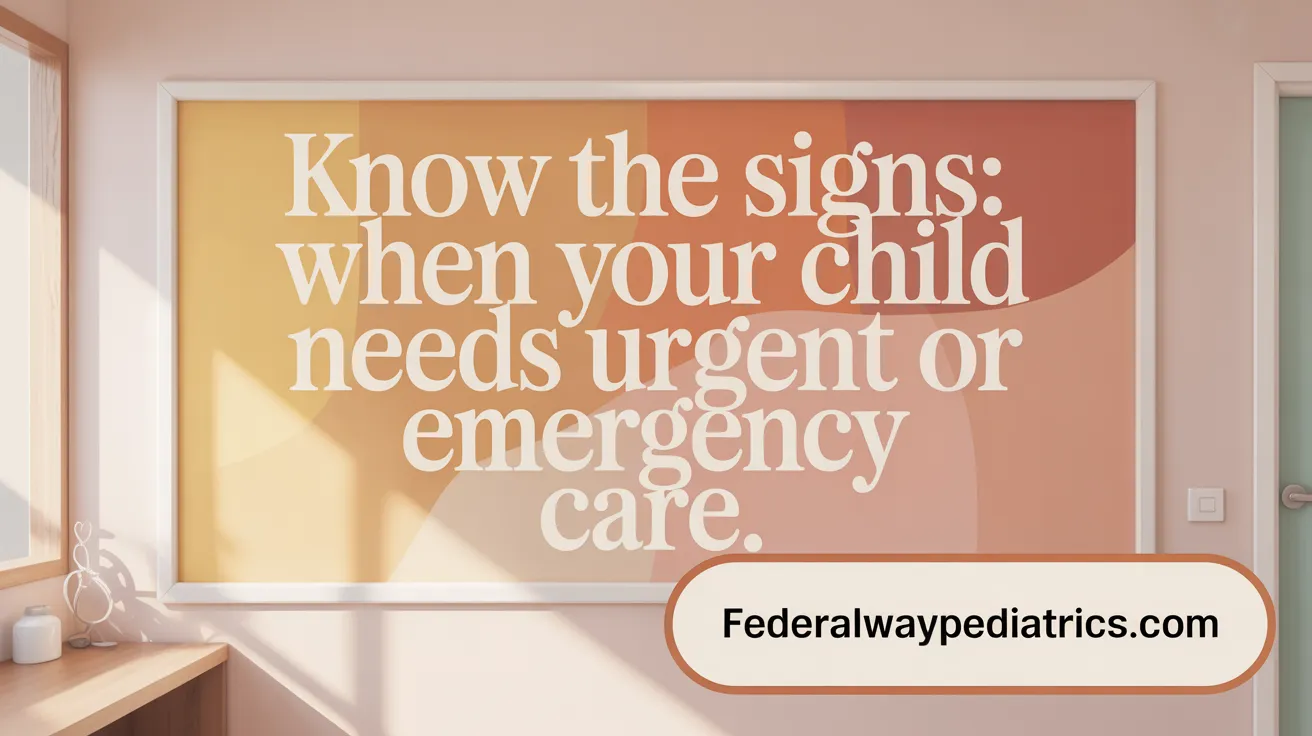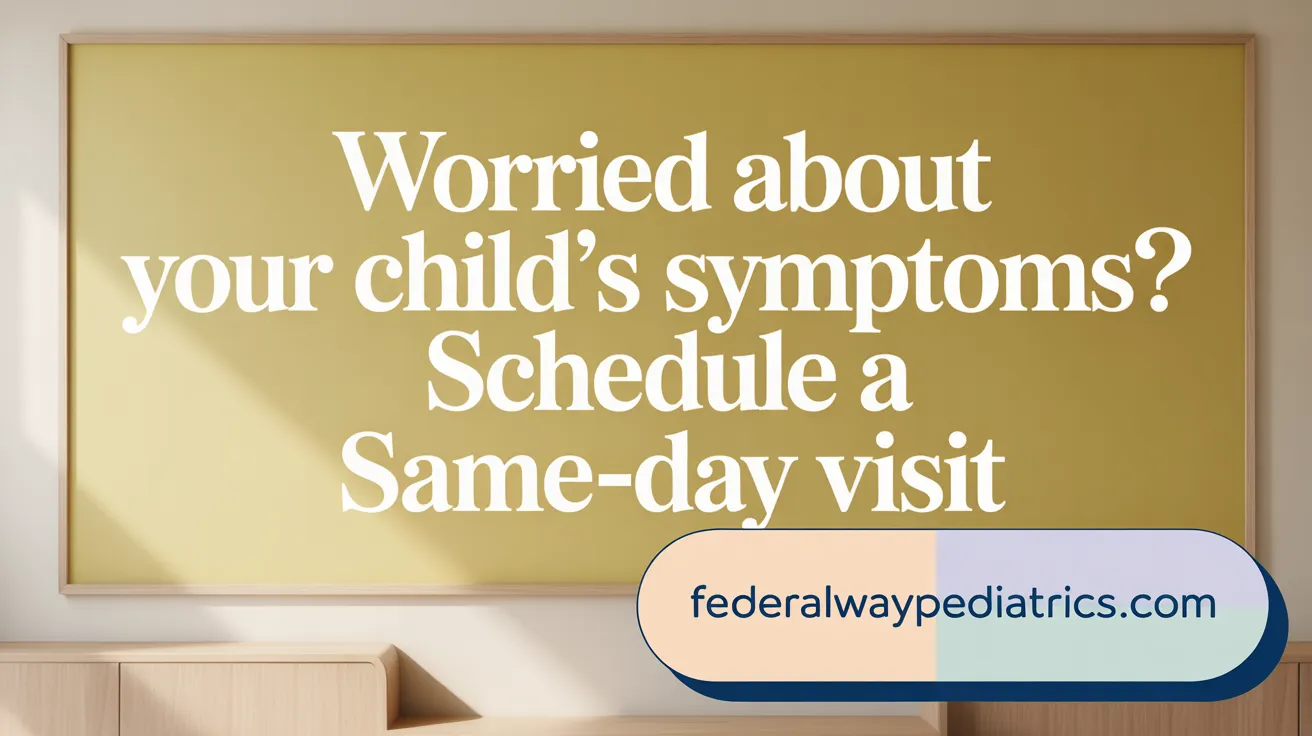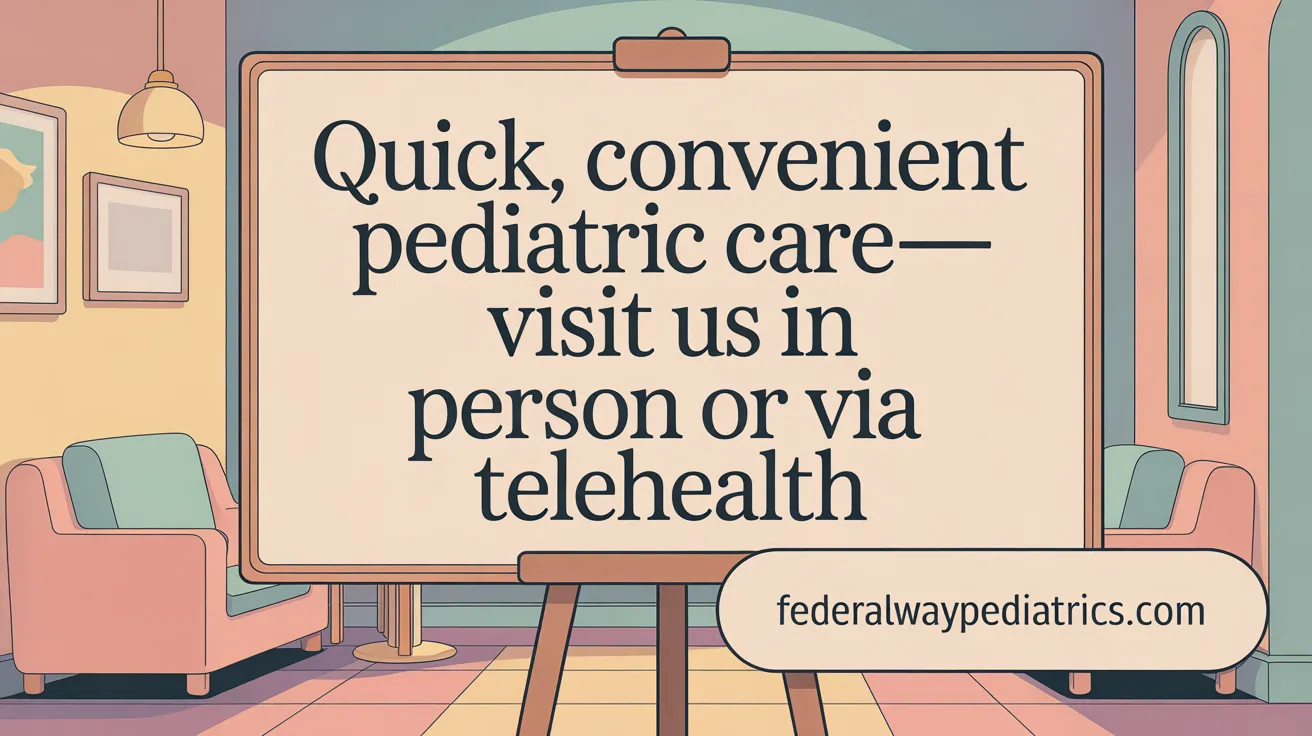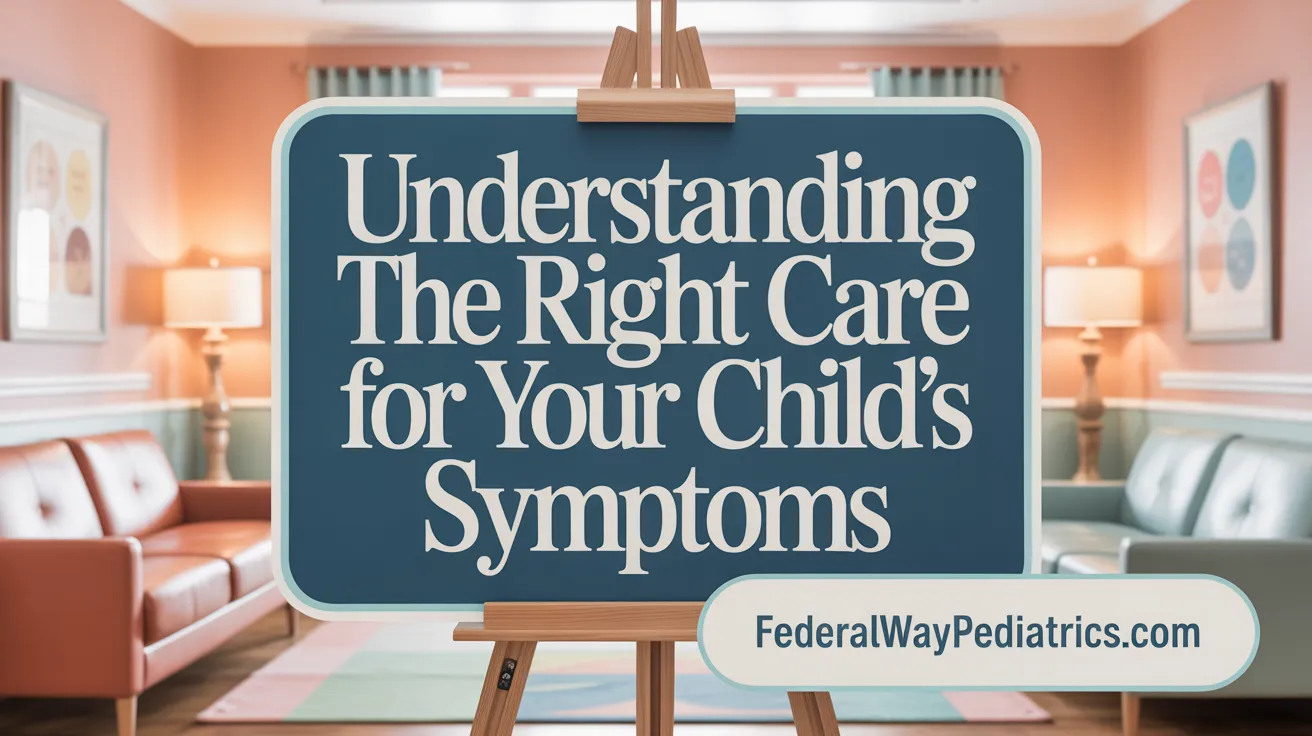Understanding When Your Child Needs Immediate Medical Attention
Parents often face uncertainty about when to seek urgent care for their child's sudden illnesses or injuries. Knowing the signs of serious health concerns and understanding the options for same-day sick visits versus emergency care help ensure children receive the right treatment promptly. This article clarifies when same-day pediatric visits are essential, highlights symptoms that warrant urgent or emergency care, explains telehealth options, and offers practical advice to prepare for sick visits.
<!-- VIDEO:eyJsaW5rIjoiaHR0cHM6Ly93d3cueW91dHViZS5jb20vd2F0Y2g/dj1mSUp5YlJJbEQxUSIsImltYWdlVXJsIjoiaHR0cHM6Ly9lbmNyeXB0ZWQtdGJuMC5nc3RhdGljLmNvbS9pbWFnZXM/cT10Ym46QU5kOUdjU19vTXVpVFdyWXVqUU9zemZmdDB0TEs3MExMVExKRFFCRzNHWHpqbGEtS29XSiZzIiwidGl0bGUiOiJEZWNpZGluZyB3aGVuIHRvIHRha2UgeW91ciBjaGlsZCBvciB5b3V0aCB0byBFbWVyZ2VuY3kiLCJzbmlwcGV0IjoiXCJTaG91bGQgSSB0YWtlIG15IGNoaWxkIHRvIHRoZSBFbWVyZ2VuY3kgRGVwYXJ0bWVudD9cIiBJdCBjYW4gYmUgYSB0b3VnaCBkZWNpc2lvbi4gV2UncmUgaGVyZSB0byBoZWxwLiBEci4gU3RlcGhhbmllIERhdmVucG9ydCwgb25lIG9mIG91ciAuLi4ifQ== -->Recognizing Urgent and Emergency Symptoms in Children

What symptoms and signs in children indicate the need for urgent or emergency medical attention?
Recognizing urgent health concerns in children and emergency symptoms in children is crucial for prompt action. Signs that warrant immediate care include difficulty breathing, indicated by rapid, labored breathing, bluish lips or face, grunting sounds, or retractions where the chest pulls in with each breath. Persistent high fever, especially in infants under 3 months, above 100.4°F, or a fever exceeding 105°F in older children, requires urgent evaluation. Seizures or convulsions are emergencies that call for swift medical attention. Unresponsiveness, lethargy, or fainting also signal serious issues that need immediate care. Severe dehydration signs—such as no urination for over 8 hours, dry mouth, sunken eyes, or a sunken soft spot in infants—are urgent symptoms. Severe injuries like deep cuts that cannot be stopped bleeding or gaping wounds, head injuries with loss of consciousness, vomiting blood, or head trauma from falls demanding urgent intervention. Allergic reactions causing facial swelling, airway obstruction, or difficulty swallowing are critical signs. Sudden inability to walk, gait changes, severe abdominal pain, or suspected broken bones with visible deformity also indicate urgent conditions. Appropriate action includes calling 911 or taking the child to the emergency room immediately. These symptoms represent real risks of life-threatening complications, and swift response can prevent long-term harm.
When to Schedule Same-Day Sick Visits for Your Child
 Parents should consider scheduling a same day sick visit for children when their child's symptoms are concerning but do not indicate an immediate life-threatening emergency. These visits are ideal for addressing ongoing or worsening health issues that require prompt evaluation to prevent complications.
Parents should consider scheduling a same day sick visit for children when their child's symptoms are concerning but do not indicate an immediate life-threatening emergency. These visits are ideal for addressing ongoing or worsening health issues that require prompt evaluation to prevent complications.
Common symptoms suitable for urgent pediatric assessment include persistent vomiting or diarrhea lasting longer than 24 hours, especially if signs of dehydration such as dry mouth, no tears when crying, or lethargy are present. High fever above 100.4 °F that persists for more than five days or does not respond to medication also warrants a same-day visit.
In addition, signs of respiratory distress characterized by difficulty breathing, wheezing, or unusual coughing should be evaluated promptly. Severe or worsening pain, such as ear pain, abdominal pain, or joint discomfort, may also require immediate attention.
If your child develops a rash accompanied by fever or joint symptoms, or if they experience sudden changes like lethargy, irritability, or a sudden inability to walk, a same-day pediatric visit can ensure timely care.
Worsening or persistent symptoms influence the urgency of scheduling a visit. For instance, a fever that remains high or rises above 104°F in older children, head injuries with loss of consciousness, or any signs of severe illness—such as difficulty breathing, ongoing bleeding, or suspected fractures—necessitate prompt evaluation by a healthcare professional.
It is essential to contact your child's pediatrician or call their office to determine if a same-day sick visit is appropriate or if emergency care should be sought. Many practices offer flexible scheduling options, including phone consultations or walk-in appointments, to facilitate timely care and help prevent unnecessary ER visits.
Accessing Pediatric Urgent Care: In-Person and Telehealth Options

Overview of pediatric urgent care services
Pediatric urgent care services are designed to address children’s health issues that require prompt attention but are not life-threatening emergencies. These services include in-person clinics, hospitals, and specialized urgent care centers that handle common illnesses like ear infections, minor injuries, rashes, and coughs. Many clinics operate on a walk-in basis or offer same-day sick visits, making it easier for parents to seek immediate care without long wait times.
In addition to physical clinics, telehealth has emerged as a convenient alternative, especially for non-urgent health concerns. Virtual visits allow families to connect with healthcare providers via secure video calls from the comfort of their home. These virtual consultations are suitable for conditions such as colds, flu, mild asthma, skin rashes, and minor respiratory issues.
Telehealth as a convenient alternative for non-urgent complaints
Telehealth platforms provide quick access to pediatric care without the need to travel to a clinic. Parents can schedule a virtual visit using online booking systems or through their healthcare provider’s app, such as MyChart, or via dedicated telehealth platforms. During the session, providers can assess symptoms, offer advice, and in some cases, send prescriptions electronically to a local pharmacy.
Telehealth is particularly helpful during after-hours pediatric care when regular clinics are closed, or in situations where minimizing exposure to others is preferred. Many providers support multiple languages, and platforms are HIPAA-compliant, ensuring privacy and security during consultations.
Steps to schedule and prepare for telehealth and in-person visits
To ensure a smooth visit, parents should gather relevant information like the child's medical history, current medications, and allergy records. For telehealth sessions, it’s important to have a device with a stable internet connection, a functioning camera, and good lighting.
First, verify if the child's symptoms are appropriate for a telehealth visit or require an in-person examination. Parents can log into the provider’s scheduling system or call the office to book a session. Arriving early for in-person visits allows time to check in and prepare any necessary forms.
For virtual visits, testing the device’s camera and microphone beforehand helps prevent technical difficulties. It’s recommended to be in a private, quiet space free of distractions, with the child comfortably settled nearby.
In urgent cases where the situation appears serious, parents should call 911 or visit the nearest emergency room immediately rather than waiting for scheduled care. Both in-person and telehealth options aim to improve access, ensuring children receive timely and appropriate medical attention when they need it most.
Distinguishing Between Routine, Urgent, and Emergency Pediatric Care
 Understanding when to seek routine, urgent, or emergency pediatric care is vital for ensuring children receive proper treatment promptly and appropriately.
Understanding when to seek routine, urgent, or emergency pediatric care is vital for ensuring children receive proper treatment promptly and appropriately.
Routine well-child visits are scheduled checkups designed to monitor overall health, developmental milestones, and immunizations. These are regular appointments, often at specific ages, such as at 2 months, 6 months, and annually after age 2. They involve preventive care, growth assessments, and developmental screenings, and are typically managed by the child's primary pediatrician (Well-child visits and preventive care, AAP periodicity schedule, Well-Child Visit Schedule).
Urgent care is suitable for children experiencing non-life-threatening but bothersome or worsening symptoms that need prompt attention outside regular office hours. Examples include ear infections, mild wheezing, sore throat, rashes, or minor injuries like cuts and sprains. Urgent care clinics can provide quick diagnosis and treatment to prevent issues from worsening but are not equipped for severe emergencies (When to visit urgent care, Pediatric urgent care vs ER, Common reasons to take your child to urgent care).
Emergency care should be reserved for critical situations that threaten a child's life or involve severe injury. Signs include difficulty breathing, loss of consciousness, seizures lasting more than a few minutes, high fever in infants under 2 months, or significant trauma such as head injuries or suspected broken bones with visible swelling (Emergency signs and when to use the ER, Emergency symptoms not to miss, When to get emergency care for your child, When to take your child to the ER).
Parents can better decide where to seek care by assessing the severity of symptoms. For mild issues, a scheduled or urgent care visit is suitable. For life-threatening conditions or when symptoms rapidly worsen, visiting the emergency room or calling emergency services is essential (Urgent care vs ER advice, When to visit emergency department).
In case of doubt, parents are advised to contact their child's pediatrician or a healthcare hotline. They will provide guidance on whether symptoms require urgent or emergency attention, helping avoid unnecessary visits to emergency departments while ensuring the child's safety (When to call the doctor, Pediatric emergency advice, What doctors wish parents knew about when to seek emergency care).
Preparing for Your Child’s Same-Day Sick Visit: What to Expect

Steps parents can take before and during a sick visit
Parents should start by gathering all necessary information, including their child's vaccination records, medical history, and a list of current medications. Writing down symptoms, their duration, and any changes helps the provider make an accurate diagnosis.
Arriving early or completing online check-in options ensures a smoother check-in process, reducing waiting time and stress.
Bringing insurance cards and any relevant health documents also helps streamline billing and record-keeping.
How to ease child’s anxiety and gather information
Explaining the visit in gentle, simple language can help reduce a child's fear of the doctor. Bringing along favorite toys, comfort items, or stories can make the experience less intimidating.
Parents should observe and note any specific symptoms such as fever, cough, rash, or pain, to communicate clearly to the provider.
Reassuring the child before and after the appointment, praising bravery, and offering small rewards can help improve their overall experience.
Typical procedures and follow-up care during appointments
During the visit, the healthcare provider will examine the child, check vital signs like temperature and heart rate, and perform a physical exam focused on areas of concern (see Comprehensive Pediatric H&P Write Up).
Tests such as throat swabs, blood tests, or x-rays might be ordered if necessary. Prescriptions for medications, like antibiotics or antihistamines, may be provided.
The provider will give guidance on managing symptoms at home, including hydration, medication use, and warning signs to watch for (see when to seek urgent care or emergency care).
Follow-up appointments or instructions for ongoing care are discussed to ensure recovery and prevent complications.
By understanding these steps, parents can help facilitate a positive, effective experience that quickly addresses their child's health needs (Benefits of same day sick visits).
Ensuring Prompt and Appropriate Care Through Same-Day Pediatric Visits
Knowing when to seek same-day sick visits empowers parents to manage their child's health effectively. Recognizing urgent and emergency symptoms ensures timely intervention and can prevent complications. Leveraging both in-person and telehealth pediatric services offers convenient access to care suited to the child’s needs. Distinguishing between routine, urgent, and emergency visits helps parents make informed decisions, avoiding unnecessary ER visits while ensuring serious conditions receive immediate attention. Proper preparation for sick visits eases the process for both child and family. Ultimately, same-day sick visits play a critical role in providing prompt, personalized care that promotes children's health and peace of mind for families.
